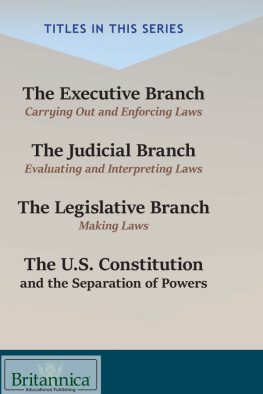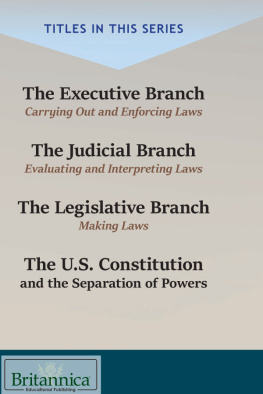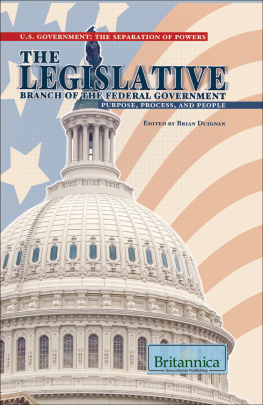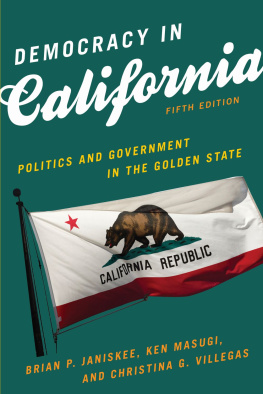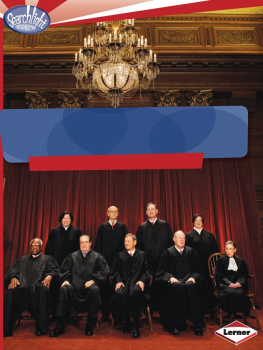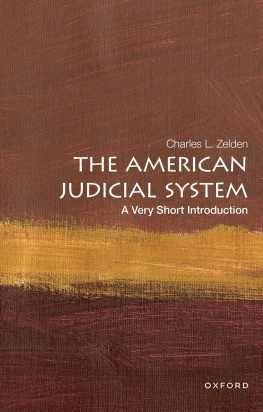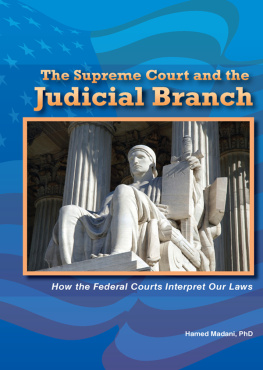THE JUDICIAL
BRANCH OF THE FEDERAL GOVERNMENT
PURPOSE, PROCESS, AND PEOPLE
U.S. GOVERNMENT: THE SEPARATION OF POWERS
THE JUDICIAL
BRANCH OF THE FEDERAL GOVERNMENT
PURPOSE, PROCESS, AND PEOPLE
EDITED BY BRIAN DUIGNAN, SENIOR EDITOR, RELIGION AND PHILOSOPHY
Published in 2010 by Britannica Educational Publishing
(a trademark of Encyclopdia Britannica, Inc.)
in association with Rosen Educational Services, LLC
29 East 21st Street, New York, NY 10010.
Copyright 2010 Encyclopdia Britannica, Inc. Britannica, Encyclopdia Britannica, and the Thistle logo are registered trademarks of Encyclopdia Britannica, Inc. All rights reserved.
Rosen Educational Services materials copyright 2010 Rosen Educational Services, LLC.
All rights reserved.
Distributed exclusively by Rosen Educational Services.
For a listing of additional Britannica Educational Publishing titles, call toll free (800) 237-9932.
First Edition
Britannica Educational Publishing
Michael I. Levy: Executive Editor
Marilyn L. Barton: Senior Coordinator, Production Control
Steven Bosco: Director, Editorial Technologies
Lisa S. Braucher: Senior Producer and Data Editor
Yvette Charboneau: Senior Copy Editor
Kathy Nakamura: Manager, Media Acquisition
Brian Duignan: Senior Editor, Religion and Philosophy
Rosen Educational Services
Hope Lourie Killcoyne: Senior Editor and Project Manager
Nelson S: Art Director
Nicole Russo: Designer
Introduction by Richard Worth
Library of Congress Cataloging-in-Publication Data
The judicial branch of the federal government: purpose, process, and people / edited by
Brian Duignan.1st ed.
p. cm.(U.S. government: the separation of powers)
In association with Britannica Educational Publishing, Rosen Educational Services.
ISBN 978-1-61530-037-2 (eBook)
1. CourtsUnited States. 2. Judicial powerUnited States. 3. JudgesUnited States.
4. Separation of powersUnited States I. Duignan, Brian.
KF8717.J83 2010
347.73dc22
2009038304
Photo credit: cover www.istockphoto.com/dra_schwartz; p.www.istockphoto.com/Stefan Klein.
Introduction
I n 1787, a convention of delegates from all but one of the American states met in Philadelphia, where they rewrote the framework of the national government. Before the Constitutional Convention, most political power had been in the hands of the states. As a result, the national government lacked the authority to conduct foreign affairs, conclude treaties with other nations, or raise an army for the nations defense. While most delegates agreed that a change was necessary to preserve the independence of the United States, they did not want to create an all-powerful central government. While still part of Great Britain, the colonies had been ruled by the British Parliament and King George III, and they did not want to repeat that situation.
Instead, the founders devised a system of government consisting of three branches. The executive branch is embodied in the president. The legislative branch comprises both houses of Congress. The third branch, the judiciary, includes the U.S. Supreme Court and the lower federal district and appeals courts. The founders also wrote into the Constitution an ingenious system of checks and balances that enabled each branch of government to prevent or revoke certain actions by the other two, thereby contributing to a balance of power among the branches.
Each branch of the U.S. federal government holds separate and distinct authority when it comes to governing the nation. Aided by the vice president and members of the cabinet, who are also part of the executive branch, the president enacts and implements laws. Congress is charged with passing the legislation that the president signs into law. Because they are elected officials, the president and federal legislators are subject to the influence of the citizens who voted them into office.
Not so with the judiciary. As sole interpreters of the nations laws, federal judges and Supreme Court justices are appointed to lifetime terms by the president and confirmed by the Senate. Lifetime appointments are a means of shielding judges and justices from political pressure, leaving them free to decide cases solely on the basis of the law. As each justice or judge is replaced by a new appointment, the complexion of the courts may change, and with it the interpretation of the law.
Judicial reviewthat is, the right to declare acts unconstitutionalwas not part of the Constitution. Yet, it has become central to checks and balances. The right of review for the federal courts was first established in Marbury v. Madison, in which the Supreme Court, led by Chief Justice John Marshall ruled that the Court had the power to declare an act of Congress unconstitutional. This established the courts doctrine of judicial review, a power held by few other courts in the world. Sixteen years later, the Supreme Court handed down a pair of rulings, McCulloch v. Maryland and Gibbons v. Ogden, that more clearly defined the power of the federal government over the states.


